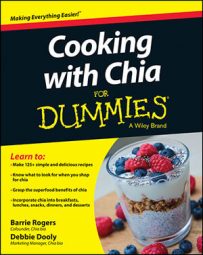Chia seeds are certainly unique. They're highly nutritious and good for your health, but there is so much more to these tiny seeds that not everyone knows. Here are some of the lesser known facts about chia that you may be surprised to discover:
Chia was used as an endurance food by ancient tribes. The Aztecs, Mayans, and other ancient tribes all used chia to sustain themselves in battles and on long running and hunting expeditions. One tribe that still survives from ancient times is the Tarahumara Indians of Mexico's Copper Canyon. They're famous for their long-distance running abilities. They're also known to use chia seeds to help fuel their epic runs.
Chia seeds were once used as currency. The Aztecs thought so highly of chia seeds that they were often used as legal tender. Conquered nations would pay their Aztec rulers in chia seeds. One ancient document refers to over 4,000 tons of chia seeds being paid annually to the Aztec Empire.
Chia crops were destroyed by Spanish invaders 500 years ago. When the Spanish conquistadors arrived in South America and were met with native people who revered chia seeds, they ordered the destruction of the crops everywhere in an attempt to take away what the natives held such regard for. They did this as part of their attempts to overtake the native tribes and establish Spanish rule.
Chia was rediscovered in the 1990s by Dr. Wayne Coates. Dr. Coates led a project in Argentina to search for cash crops that the farmers in the area could benefit from growing. He tested a number of different plants to assess their commercial potential, and when he analyzed chia seeds, he discovered their fantastic nutrient profile and dedicated all his research to bringing chia back to a commercial level so that people worldwide could benefit from the seeds.
Chia is a member of the mint family. Chia seeds are harvested from Salvia hispanica, which is a flowering plant in the mint family. Insects naturally don't like mint and generally leave the plant alone, which is good news for chia — it can be grown without the use of pesticides.
The flowers that chia seeds come from are purple and white. Fields of the plant Salvia hispanica, where chia comes from, are beautiful when in full bloom. Sometimes all you can see is fields of purple as far as the eye can see. The plant needs to flower to produce chia seeds, and the flowers are a beautiful purple and white color.
Chia seeds can be sprouted. If you want to sprout the seeds to use in salads, all you need to do is sprinkle some whole chia seeds onto wet paper towels and keep the paper towels wet for one week. You'll end up with tiny sprouts that you can use as desired. Some people believe that there are more nutrients in sprouted seeds.
Chia is high in selenium. Selenium is an important antioxidant needed for cell metabolism. It's usually hard to find in foods, but chia seeds are a great source of this antioxidant.
Chia is grown between 23 degrees north and 23 degrees south latitude. The chia plant is very temperamental and requires very specific growing conditions. It will not tolerate frost, but it needs cold weather to produce the high levels of omega-3 fatty acids. The ideal place to grow chia is between 23 degrees north and south of the equator. This area provides some of the right conditions needed to yield chia seeds.
Babies can benefit from chia. Babies as young as six months old can start eating chia. Mix milled chia seeds into pureed fruits and other foods, and your baby can benefit from the high amounts of omega-3s that are so important for brain development. Even before six months of age, if a mother eats chia, her baby can benefit — both throughout pregnancy and while the baby is being breastfed.

